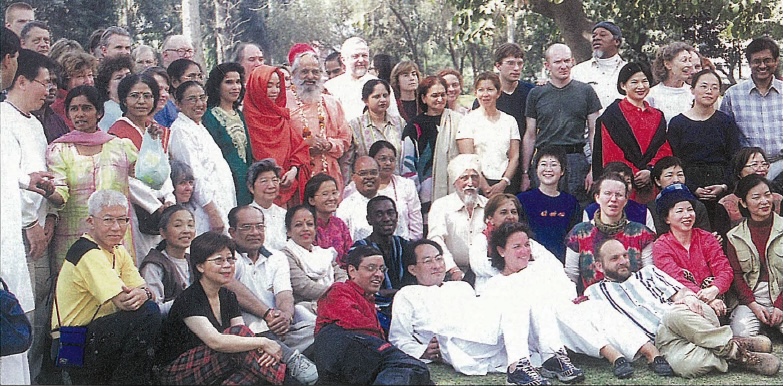By Kailash Dakshinamurthi
Pilgrimage. I’ve always begun one with spiritual preparation and an understanding of what I expect to experience. Tours are my business, and I have organized pilgrimages before. But the Maha Kumbha Mela is fascinatingly different. I don’t know how to prepare for or comprehend this event. Before I even have time to research more than the basic principles, I am off on a seven-hop flight to Allahabad. En route I read that Madonna and Paul McCartney may also come, and I become even more perplexed about this pilgrimage.
Arriving in Allahabad, I witness everywhere streets packed with vehicles, each crammed with people. This cacophony isn’t the Mela, however, just India in general! My wife Indra and I spend the next few nights preparing our camp for our group of 165 international pilgrims from 22 countries who will soon join the multi-millions of seekers.
In the evening the Shankaracharya of Kanchi visits our camp to meet with our resident swamis, Mahamandaleshwar Swami Veda Bharati and Swami Chidananda Saraswati (Muniji). Security is tight. Armed police stroll through our camp. Metal detectors are installed. TV crews abound. The world has taken note of the Kumbha Mela, although crews seem most fascinated taking pictures of sadhus with cellular phones or of the naked nagas. It’s what we don’t understand that fascinates us. Indians are speaking English. Westerners are speaking fluent Hindi. The boundaries that separate the so-called “East” and “West” are ever more superficial. Hundreds of people sing bhajanas as the sun settles peacefully over the Ganga River. The Mela is full of orange-robed monastics, some visiting jovially, some walking contemplatively, some begging unceasingly. I marvel at the greatopportunities this life has presented me, feeling divinely blessed to be part of such a celebration.
On the main auspicious day, Mauni Amavasya, about 20 men from our group don dhotis and leave camp at 4:00 am, walking to the ahkara camp to wait for the procession to begin. First came the naked nagas. After warming themselves around a fire in the morning cold they raised a yell and charged out of the camp, rushing for the river. Next was a jostling of various archarya groups, moving into line for the ride to the waiting river. Even by 5:00 am the crowd was immense and one’s strength was already challenged to keep from being swept away by the push. But fear has no place on a pilgrimage, and the frenzied devotional excitement replaced anxiety. Finally, we found Swami Veda Bharati’s decorated “chariot.” Elephants and horses have been replaced now by tractors and wagons decked with flowers and a throne for each acharya and a few of his followers. Shouts of “Jai” and Sanskrit stotras filled the morning air.
As we passed the thousands of faces of my fellow pilgrims, I was inspired by their faithful devotion. So many people would soon be fulfilled by their auspicious dip. Crossing the river, we approached the sangam. There I finally glimpsed the Yamuna River and watched the sun rise over the Ganga. Now was the most auspicious time. With wooden barricades the police held back the masses for us to remove our outer clothing and jump into the river. I dipped first for my wife, then my mother, then my guru. I had never seen so dense a crowd or so many people in one place. It was all simply incomprehensible. Reaching our campsite, I watched the energy of the pilgrims who had taken a dip. They had truly had the darshan of Mother Ganga. I wanted to dance.
Kailash Dhaksinamurthi and his wife Indra run Search Beyond Adventures, the tour company that organized this Mela tour for Swami Veda Bharati
